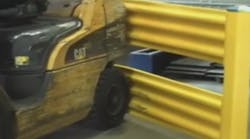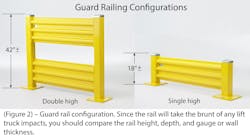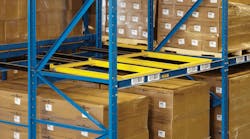Plants and warehouses have had to squeeze more traffic into less space as the cost of real estate has risen over the years. With more product and equipment packed tighter, operating with more just-in-time logistics, the risk of lift truck impact is greater than ever. That puts your people, production and assets at risk.
OSHA estimates there are 68,400 powered industrial truck accidents annually. About 95,000 workers suffer some kind of injury in these accidents, resulting in lost production, facility damage and workers compensation claims.
“As plant managers try to bring as much rack and material into the warehouse as possible, lift trucks run tighter in the aisles, making impact more likely,” says John Ellis, a regional sales manager at Steel King Industries, a Stevens Point, Wis.-based manufacturer of pallet rack and warehouse safety products.
“Even the best of plant operations can expect some fork truck impact, so it is important to minimize any damage and production downtime with the proper safety equipment – like a football player wearing a helmet and pads,” adds Ellis.
Pallet Rack Protection
Most of the damage in warehouse pallet rack occurs at the row end, where lift truck operators have to turn into the aisles, according to Ellis. If they miscalculate going around the corner, they will swing into end row pallet rack.
Rack damage is also common along an upright’s first 6” to 12” of column from the floor due to lift truck impact, particularly at tunnels, drive thrus and intersections, where maneuvering is tight. Additional damage can occur when lift truck operators push pallets, empty or with product, against end row uprights, which can bend their diagonal or horizontal bracing.
“To prevent pallet rack damage from lift trucks at end rows and intersections, one of the cost effective methods is to install low-profile, high-strength, safety steel angle as protection along high-traffic routes,” says Ellis. To be most effective in these areas, he suggests the safety steel angle should protect 3” or 4”-wide upright columns, and offer right, left or double-ended guards so it works with virtually all end row racks.
Such pallet rack protection can be particularly important in freezer applications where space is very restricted, the floor can be slippery and reaction times slowed by the cold.
Whole Plant Protection
For more universal, plant and warehouse protection from lift truck damage, more comprehensive pre-engineered industrial guard railing systems can offer more complete safety.
While some maintenance staff make and install their own in-house fabricated guard railing, this diverts them from their production and maintenance responsibilities. It also requires them to design the guard railing, purchase materials for it, fabricate it, drill it, paint it, and install it, when they are not experienced in engineering the railing for maximum safety.
A safer, more efficient answer in recent years has been pre-engineered, prefabricated industrial guard railing systems, which can protect a whole range of plant and warehouse applications. These applications can range from worker, production, inventory, and loading areas to walkways, aisles, mezzanines and in-plant offices.
“Pre-engineered industrial guard railing systems can serve as a visual and physical barrier between staging and work areas, including machinery such as conveyors, computer consoles, electrical panels, HVAC equipment and freezer-cooler controls,” says Ellis.
Standard construction of the pre-engineered railing systems consists of corrugated steel rails that bolt to square tubular columns. The columns are pre-welded to heavy steel base plates, which are anchored to the concrete floor. Anchor bolts, steel post caps and rail hardware are usually included in the package. The rails and posts are usually painted a bright safety color for easy visibility.
Commercially available guard railing systems have a few advantages over in-house fabrications. First, they cost less due to mass component production, and have lower labor costs as well.
Second, these systems are easy to install. No core drilling, cutting, welding or painting is required. Installation can be handled by in-house personnel or distributors of the product.
Third, the pre-engineered, pre-fabricated guard railing systems are safer than in-house made since they are specifically designed for lift truck impact. They are also modular, expandable and relocatable, and individual parts can be replaced if damaged. Nearly any rail length is available, which reduces installation time, and common lengths are stocked for quick order shipment.
Guard Railing System Specification
When talking about guard railing, you need to understand some terminology. Basic components include guard rails and posts. To the right are two standard railing heights: single high (18”) and double high (42”).Two basic posts are shown below.
“Most manufacturers treat rail ‘lengths’ not as the length of the rail itself, but as the center-to-center distance from column to column,” explains Ellis. “Actual rail lengths are 4” to 5” less than the stated length, depending on the post size.”
You can measure the areas you want to protect, or contact a distributor of guard railing to do it for you. Once you have decided on either a single or double high system, you can easily create a bill of material to compare various systems.
Two easy comparisons are price and value. It is easy to compare prices and component weights when analyzing a few proposals, but you should go one step further.
“Since the rail will take the brunt of any lift truck impacts, you should compare the rail height, depth, and gauge or wall thickness,” says Ellis. “How many ribs or corrugations does the rail have? Is the rail edge ‘closed,’ or is it ‘open’? Open edges usually require you to install a protective plastic stripping to cover the sharp edges of the steel.”
“The connection between the rail and the post is also important,” adds Ellis. “How many bolts are used for this connection? What grade or strength of hardware is supplied? Are connector holes or vertical slots provided? Slots allow you to adjust the posts on uneven floors.”
Other considerations include post size and gauge, base plate size and gauge, anchor size and quality and type of finish. These considerations will also contribute to the structural strength, appearance and maintenance of the railing system.
“What you are trying to achieve is a balance between heavy construction, purchase price, value and ease of installation,” concludes Ellis.
This article was contributed by Steel King (www.steelking.com).







